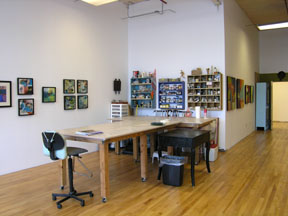 |
| My cast face |
During the week of classes after the encaustic conference at Castle Center for the Arts in Truro, I was pleased to take Kim Bernard's post-conference workshop on casting wax from plaster molds. I intend to write a post on that workshop showing how the plaster molds were made, but I neglected to take photos of the cast wax objects that were produced. I'm hoping that I will be able to get those photos to make the posts complete, but in the meantime, I thought I would show you my experience with having my face cast in plaster during the class.
These photos were all taken by April Nomellini with my iphone. She did a great job documenting the process, as you will see. (Here's a link to a site showing April's work and I also showed April with the work she made in my Mixed Media and Encaustic class.)
 |
| I was feeling a bit leary as Kim placed towels around my neck |
I had never had my face cast before and thought I would like to give it a try when Kim asked for a volunteer. Whether I would be able to stay still enough and not laugh or speak during the process was questionable, but I decided to go for it.
 |
| Applying vaseline - especially to eyebrows and eyelashes |
The first step is to coat the face well with vaseline as a release agent so that the plaster can be removed from skin and hair more easily.
 |
| Plaster gauze cut in strips |
This process uses the material from which casts for broken bones were previously made before new processes were developed. Small strips of plaster-coated gauze are cut and soaked in water just before applying.
 |
| Kim was very good about keeping the plaster out of my hair |
 |
| Notice the neat edge she put on the mask |
The application took maybe 10 minutes and then I had to wait for another 5 minutes or so -- and all that time I had to stay still and not smile, frown or otherwise move my facial muscles. And I had the worst itch on my upper lip!
 |
| I like this image with the large mural of a face in the background. |
 |
| Can you see that the casting has gotten stiffer? |
I was a little worried that this might feel claustrophobic, but it didn't. The plaster just felt cool and wet, a good feeling because it was hot in the shed and the sun was beating down.
 |
| And there it is! |
 |
| Kim is explaining that the outside of the cast has to be built up with more plaster before it can be used as a mold. It should be about an inch thick. |
 |
| Here is the inside of the cast - complete with a few real eyelashes and some makeup. |
This was quite an experience, and I'd like to complete the process by adding plaster so that I could cast it in wax to see it as a positive image. It does feel kind of strange to be looking at myself this way with no animation and closed eyes. It's actually a little chilling and reminds me of the death masks that used to be cast on corpses. Maybe it will look different in wax. Let's hope so.
A big THANK YOU to Kim for doing such a great job and to April for taking such good photos!


















4 comments:
Wow! I remember doing this in art class in junior high school. We used the molds to cast clay. Probably kids can't do this anymore because of all the ADD and ADHD. I can't wait to see the wax casts.
Nice post, fun process. You were a terrific guinea pig!
Simply put....INSPIRATIONAL!
It looks like a lot of fun....love your arty blog. Now following!
Ciao Bella!
CREATIVE CARMELINA
Hey Nancy! I see that while I was away sailing you were busy creating this great post. I will share it with my future casting students as it documents the process so thoroughly. Thanks for being such a great student, volunteering your face and sharing it with your blog followers!
Post a Comment